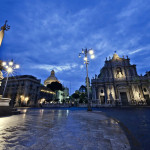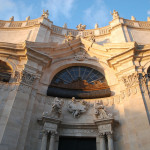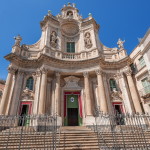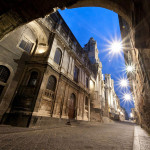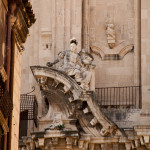St. Agatha on February 5th
- 10:00 h
- 4 KM
- Intermediate
Sant’Agata on 5 February is a very special day of celebration to celebrate the Patron Saint of Catania. The long festivities of February 4th, during which the fercolo of St. Agatha makes the external tour. On February 5th, around 6.00 pm, the roar of fireworks announces the exit of the patron saint of Catania and the beginning of the third day of celebration along the streets of Catania.
The internal tour – or inside the walls – winds along the baroque streets of the city. Starting from Piazza Duomo, the procession of devotees goes to via Etnea, passing the squares and intersections that divide it. Although shorter, this second itinerary takes place more slowly. Because of the large amount of candles brought as offer to the Patron Saint, the fercolo will often stop to remove the wax now dissolved and thus ensure the safety of the celebration.
In this day, we suggest you to anticipate the fercolo and to wait for it along the stops of its path. This will allow you to witness the passage of the St. Agatha and to admire more closely the fercolo and the reliquary bust. We assure you that your wait will be repaid.
The itinerary of St. Agatha on February 5th
From Piazza Duomo go to Via Etnea, the fercolo passes in front of the Church of the Abbey of S. Agata and the Church of the Collegiata. The route along the noble street of Catania continues in Piazza Stesicoro and in front of the historic Bellini garden and then proceed to Via Caronda. You will notice that the route of the fercolo is preceded by the devotees that carry the candles, by hand (or on the shoulder), as an offer to the St. Agatha. The route of the offer winds along the Via Caronda and then stops in Piazza Cavour (“u burgu” – in the dialect of Catania). We advise you to witness the passage of the light accesses that illuminate the night of the feast of St. Agatha, it is a moment full of faith and devotion where the size of the candle symbolizes the greatness and importance of the offer and the “grace” asked to the Patron Saint.
After reaching Piazza Cavour, the fercolo of S.Agata stops to watch the fireworks. After the pyrotechnic show to the rhythm of music on February 3rd, these are surely the most spectacular fireworks you can watch during the feast of St. Agatha. But be careful, the fireworks take place late at night, we suggest you to plan to stop (and return to your b&b or hotel) and then reach the feast again.
The internal route of the fercolo of St. Agata has not yet been completed, once again in Via Etnea the procession continues with the famous via Sangiuliano. Once the fercolo used to run along this slope, but in recent years it is preferred to follow it at a crawl – this did not however affect the charm of the stop.
Among the baroque churches (UNESCO heritage) of via Crociferi prepare to attend another moment of great emotion. Separated from the street only by the railings of the church of St. Benedetto, the Benedictine nuns dedicate their song to the patron saint – it takes place in absolute silence under the attentive looks of devotees and curious. Here the road becomes narrow and many are poured out to witness the singing of the nuns, if you are not comfortable in moments of great confusion, we advise you not to go too close and to follow the procession from a place not far away.
A few meters separate St. Agatha and her devotees from the final salute. The return to the Cathedral is full of emotion, the devotees waving their white gloves to greet S. Agata who will re-embrace the city only in a year (and on August 17th, for the feast of St. Agatha of August). So just before returning to the Cathedral, one last time St. Agatha turns looking at the Piazza Duomo to give all the devotees her benevolent greeting.
Piazza Duomo
It’s the main square in Catania; via Etnea, Via Vittorio Emanuele and Via Garibaldi, the three main roads of the old town, cross in this place. It is surrounded by many monuments and in its centre is placed the famous “Elephant’s fontain”, built by Gianbattista Vaccarini.
To admire the square and its monuments, sit at one of the historic bar where you can taste the local cuisine.
St. Agatha Abbey
Next to the Cathedral, overlooking Via Vittorio Emanuele there is the St. Aghata’s Abbey. The Abbey was completed in 1735 and some critics think that this building is the architect Vaccarini’s masterpiece. A jewel realized in Sicilian baroque style.
Visit the terraces of the Abbey to admire the city in a different way.
Collegiata Church
It’s one of the oldest churches in the city, in fact, the original structure was probably built in the early centuries AD. After the earthquake in 1693, the Church was destroyed almost all and it was rebuilt by Antonio Amato, who modified it.
Piazza Stesicoro
Piazza Stesicoro takes its name from the Greek poet Stesichorus. It is crossed and divided in two parts by the main street, via Etnea. The two sides of the square have different architectural styles: on East stands the monument dedicated to Vincenzo Bellini, on the other side the roman amphitheatre.
Bellini’s garden
The Bellini’s Garden is better known as Bellini’s Villa, it belonged to the Biscari’s family, who gave it to citizenship in 1854. It’s in the heart of Catania and you can come in from several sides, but the main entrance is located along the famous via Etnea.
Villa Bellini is the ideal place where to take a relaxing walk with your family.
Via Sangiuliano
Via Sangiuliano is one of the most typical and long street of Catania’s centre. It starts from the sea, it arrives to the “Quattro canti” (the cross between via Etnea and via A. Di Sangiuliano) and from here, it continues, steep and with a flooring in lava stone with some wide cracks between a plate and another.
It is an obliged stop during the celebration of St. Agatha.
Via Crociferi
Via Crociferi is one of the oldest Catania streets in the heart of the city, it starts in Piazza San Francesco D’Assisi through the famous St. Benedict triumphal arch. It is considered the symbol of Baroque in Catania, because there are some of the most beautiful eighteenth-century churches of the city.
St. Benedict’s Church
It’s located at the beginning of via Crociferi, the Saint Benedict’s Church is an example of late baroque architecture in Catania. It was rebuilt immediately after the earthquake in 1693 with the S. Benedict’s arch, that was erected in 1704.
